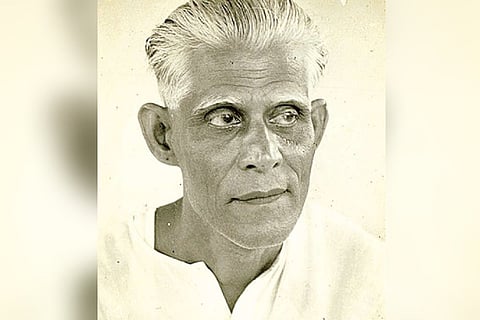THOSE WERE THE DAYS: The Manikodi Movement
Chennai
Poetry might be the essence of a language, but it is prose that is the main corpus. From the Sangam period, Tamil had a lopsided affinity to poetry. The 20th century and particularly Madras broke that stranglehold and gave prose a chance to proliferate. The growth of prose was astronomical and attracted the first time literates in any family. It could even be said that Tamil poetry seemed squeezed to the corner of cinema songs.
A major renaissance movement in the 1930s termed the Manikodi Movement can be directly held responsible for the mushrooming of both prose writers. This Movement lasted only six years and had an impact on the future that left historians wonder stuck.
The first Tamil novel came out in 1879 and became the dominant form of reading. Disturbing historic events like the World War, Depression and the Civil Disobedience Movement against the ruler changed readers’ sensibilities. The copycat novels were not enough to satisfy the readers’ ballooning curiosities and interests. It was then the Tamil short story that would not test the limited patience of the reader became the dominant force. Short stories were much tougher to put on limited space for writers who could ramble on and on earlier. It was an experiment for a field that desperately needed reform but were there enough labs to pursue this trial?
Manikodi was one. It was a 60-page magazine supporting succinct writing — short stories and essays. The name on the masthead was a description of the national flag in a recent fiery poem by Bharathi Thayin Manikodi roughly meaning, “our mothers’ jewelled flag”. Coincidentally, Kamban also mentions a Manikodi as the first thing Rama sees flying over Mithila, where the lovely Janaki awaited his garland.
In September 1933, the first issue of Manikodi came out. The three men who founded the magazine couldn’t have been more different from each other. However, Chokkalingam, Srinivasan and Ramasamy had one common binding force — patriotism in a time of divided loyalties.
Srinivasan had worked as a Sunday observer in London. Chockalingam had worked in the Tamil press. Ramasamy was gifted to have been introduced to Tamil literature by Bharathi himself.
Ramasamy was a talent scout especially for writers with simple styles and it was said to post his editing, the story could be understood by rickshaw-pullers in George Town. In this shadow of minimalism, writers like Mowni and Pudhumaipithan enthralled the Tamil world with realistic writing.
Ramasamy encouraged a shift to social themes arguing literature could not only be a vehicle for entertainment. It should be one for social change and upliftment as well. His writers took this principle to heart and rival Kalki even ridiculed the Manikodi writers for taking literature too seriously.
The initial years had essays espousing nationalism (political cartoons, quotes and news) and an occasional short story. Early issues even had Ramayana retold from the pen of a journalist. But with BS Ramaiah taking over as editor, a flood of short stories changed Manikodi into a literary magazine. BS Ramaiah started as a waiter in a Madras hotel met the founders in prison. Soon, he eclipsed all of them and changed Manikodi to the format it’s remembered today. Later, in 1982 Ramaiah got the Sahitya Academy award for a book on the Manikodi years.
Around 1935, more than 100 short stories were published each year and the Manikodi delved into the international market to pick stories to translate as well. It was as if Manikodi was catering to an audience’s insatiable hunger for prose.
Ramaiah’s legion of writers was different in their writing but socially clones. Most had similar backgrounds and were born in the 20th century. Their camaraderie was remarkable. They forgot they were rivals competing for the same space in history and spent time in literary discussions late into the nights. They helped the magazine in layouts, and even lent a hand to the printer to pull his treadle and some even stood at street corners selling the copies. To them, literature was a passion, and this collective fervour was what triggered the Manikodi Movement.
It was not without controversy that this cohesive group could progress. They unitedly fought against Kalki when the latter said Bharathi was not a Mahakavi. Soon the debate deepened into disparagement. The Manikodi group questioned the authorship of Kalki’s books accusing him of plagiarism. But it was a typical David and Goliath tale. The Manikodi was struggling to sell 1,000 copies. The Anandavikadan headed by Kalki was easily selling 50,000.
But dreams don’t last forever. Somehow the enthusiasm of running an upstart magazine waned. Financial viability eluded it and soon management struggles led to the firing of Ramiah. The closure of Manikodi was imminent. Looking back, the Manikodi writers dispersed not like shriveled leaves in an autumn wind. Like life in the seeds of a pod shattering in the summer rain, they planted themselves in every corner of the print world and enriched the literature landscape of Madras.
— The writer is a historian and an author
Visit news.dtnext.in to explore our interactive epaper!
Download the DT Next app for more exciting features!
Click here for iOS
Click here for Android

